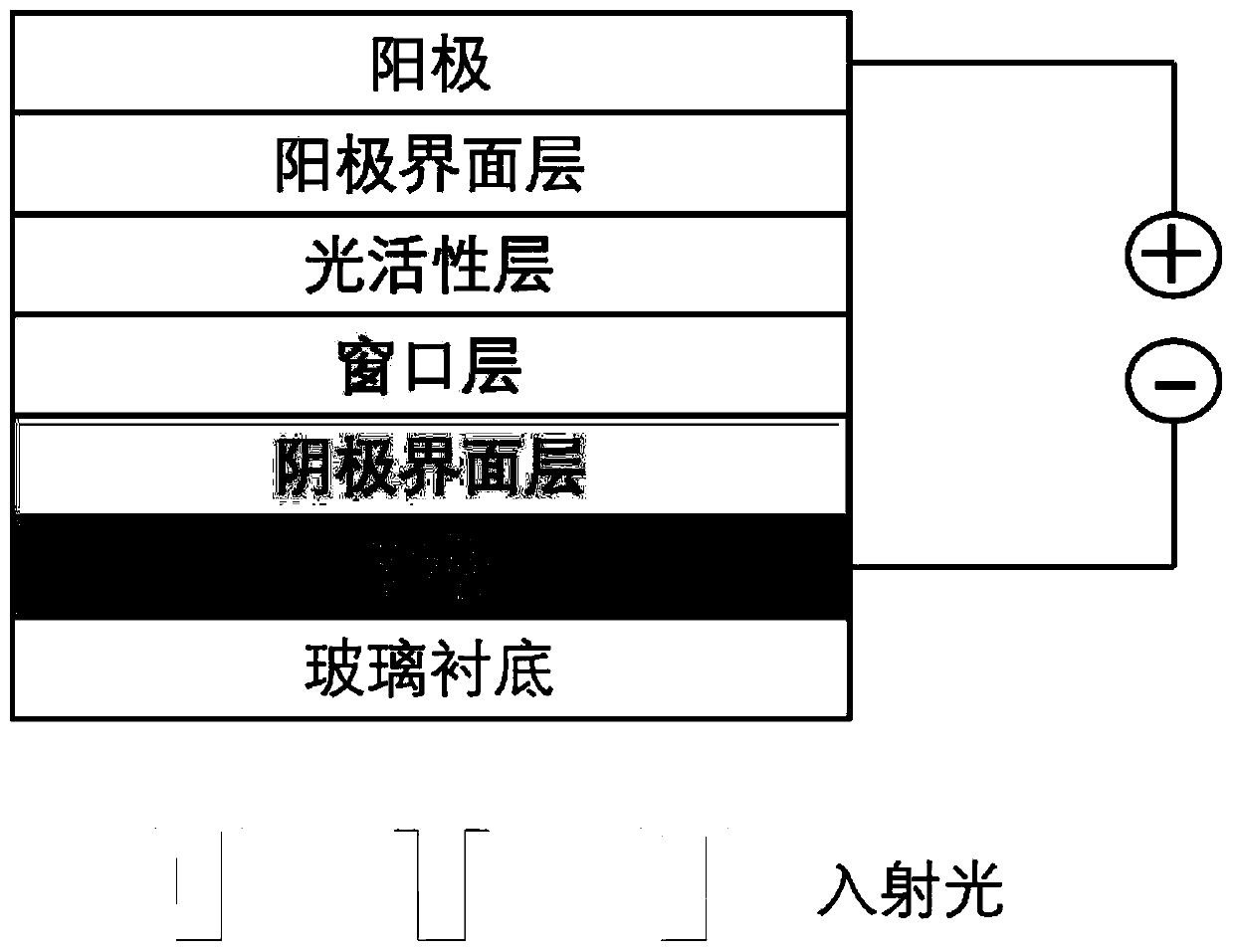Cadmium telluride nanocrystalline solar cell and preparation method thereof
A technology of solar cells and nanocrystals, applied in circuits, photovoltaic power generation, electrical components, etc., can solve the problems of few application reports, and achieve the effects of simple and convenient preparation process, enhanced stability, and increased current
- Summary
- Abstract
- Description
- Claims
- Application Information
AI Technical Summary
Problems solved by technology
Method used
Image
Examples
Embodiment 1
[0047] Effects of different concentrations of PTAA solutions on CdTe nanocrystalline batteries
[0048] The preparation steps of the cadmium telluride nanocrystalline solar cell are as follows:
[0049] (1) Cleaning of ITO conductive glass substrate: ultrasonically oscillate the substrate (15mm×15mm in thickness, 80nm in ITO) in toluene for 5min at an ultrasonic frequency of 35KHz, then add alkali in acetone and dropwise Ultrasonic oscillation in deionized water of liquid for 15min, the ultrasonic frequency is 35KHz, then ultrasonically in deionized water, the ultrasonic frequency is 35KHz, 10min each time, repeat 5 times until there are no bubbles on the surface of ITO, finally add isopropanol ultrasonic, the ultrasonic frequency is 35KHz , and ultrasonically oscillated for 10 minutes to clean the surface of the ITO substrate, and then put the ITO sheet into a constant temperature oven at 85° C. for static drying to obtain a cleaned ITO conductive glass substrate.
[0050] (...
Embodiment 2
[0062] Effects of different heat treatment temperatures of PTAA on CdTe nanocrystalline batteries
[0063] The preparation steps of the cadmium telluride nanocrystalline solar cell are as follows:
[0064] Except that the thickness of the CdTe film in step (4) is changed to 500nm, the concentration of PTAA solution in step (5) is changed to 5mg / mL, and the heat treatment step is changed to: Heat treatment at 120° C., 130° C., 140° C. and 180° C. for 10 minutes, and other steps in Example 2 are the same as in Example 1. A cadmium telluride nanocrystalline solar cell device with a structure of ITO / ZnO / CdS / CdSe / CdTe / PTAA / Au is obtained.
[0065] The relevant parameters of the cadmium telluride nanocrystalline solar cell device obtained in Example 2 are compared in Table 2. I in Table 2 sc stands for short-circuit current, V oc Represents the open circuit voltage, FF represents the fill factor, and PCE represents the photoelectric conversion efficiency.
[0066] Table 2 Examp...
Embodiment 3
[0070] Effects of different Spiro heat treatment temperatures on CdTe nanocrystalline batteries
[0071] The preparation steps of the cadmium telluride nanocrystalline solar cell are as follows:
[0072] Steps (1)-(3) are the same as in Example 1, and in step (4) the CdTe thin film is changed to 5 layers stacked with a total thickness of 500nm.
[0073] (5) Preparation of Spiro-OMeTAD thin film: 72mgSpiro-OMeTAD, 9mgLi-TFSI, 29μl TBP are dissolved in the mixed solvent that 1mL chlorobenzene and 0.1mL acetonitrile are formed, magnetic sub-stirring overnight, obtain light orange solution, step (4) The treated substrate is placed on a homogenizer (KW-4A type), the above-mentioned light orange solution is added dropwise, and a Spiro-OMeTAD monolayer is obtained by high-speed spin coating (the spin coating rate is 2000rpm, and the time is 20s), and placed on the heating table Heat treatment was carried out for 10 minutes to remove the organic solvent, and the thickness of the obta...
PUM
| Property | Measurement | Unit |
|---|---|---|
| thickness | aaaaa | aaaaa |
| thickness | aaaaa | aaaaa |
| thickness | aaaaa | aaaaa |
Abstract
Description
Claims
Application Information
 Login to View More
Login to View More - R&D
- Intellectual Property
- Life Sciences
- Materials
- Tech Scout
- Unparalleled Data Quality
- Higher Quality Content
- 60% Fewer Hallucinations
Browse by: Latest US Patents, China's latest patents, Technical Efficacy Thesaurus, Application Domain, Technology Topic, Popular Technical Reports.
© 2025 PatSnap. All rights reserved.Legal|Privacy policy|Modern Slavery Act Transparency Statement|Sitemap|About US| Contact US: help@patsnap.com



